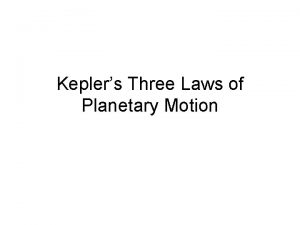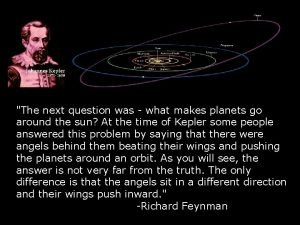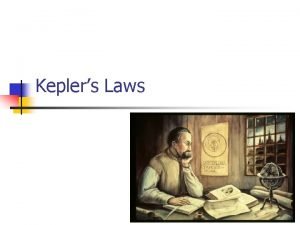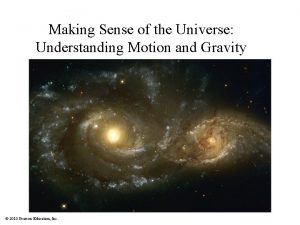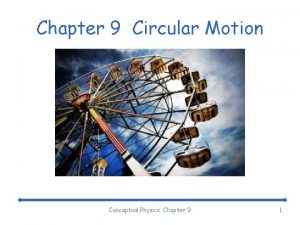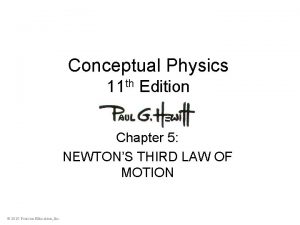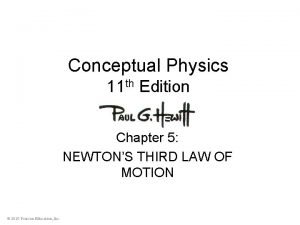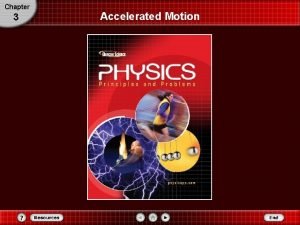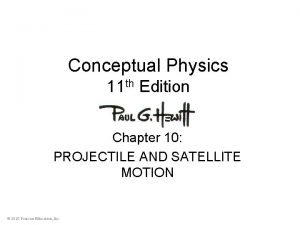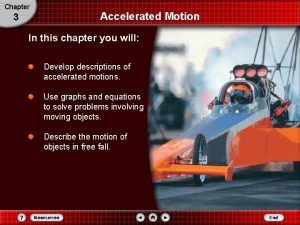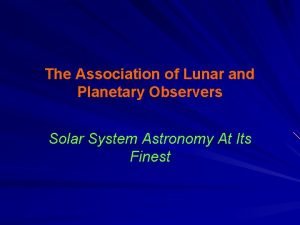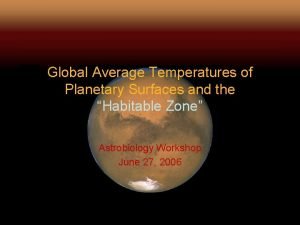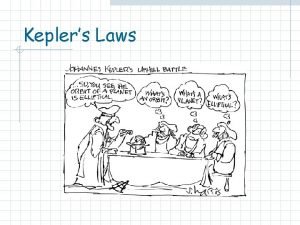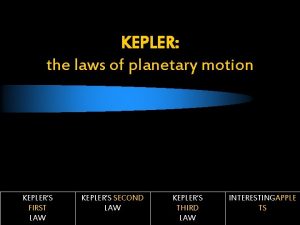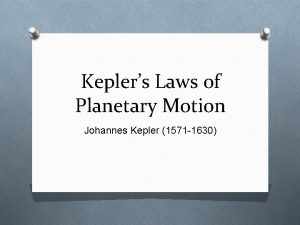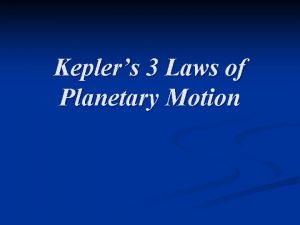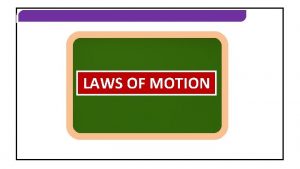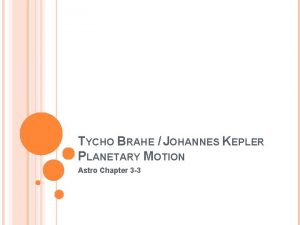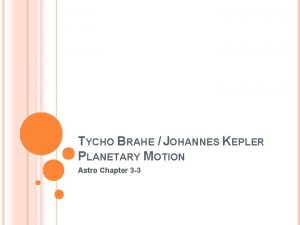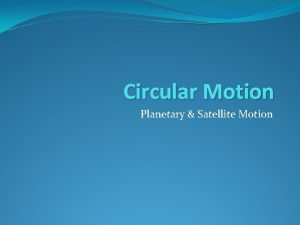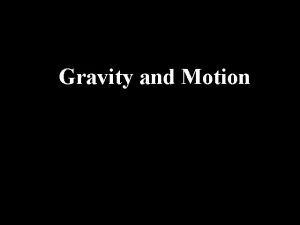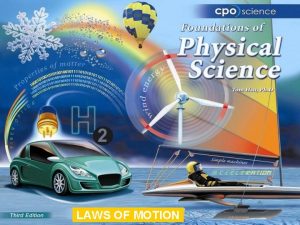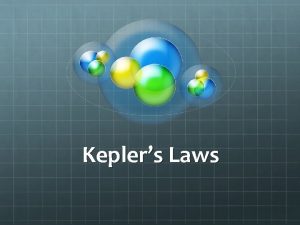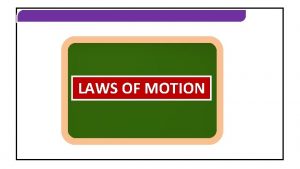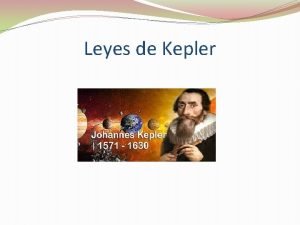KEPLER the laws of planetary motion Physics Chapter























- Slides: 23

KEPLER: the laws of planetary motion Physics Chapter 7—Circular Motion KEPLER’S FIRST LAW KEPLER’S SECOND LAW KEPLER’S THIRD LAW INTERESTINGAPPLE TS

Johannes Kepler l Born on December 27, 1571 in Germany l Studied the planetary motion of Mars u Used HOME observational data of Brahe

Tyco Brahe l Danish astronomer who hired Kepler as his assistant l Came up with accurate observations of Mars with his naked eyes l Assigned Kepler to develop a theory of planetary motion using his observations HOME

Instruments l Tyco Brahe u only compass and sextant u No telescope – naked eye HOME

HOME Kepler’s FIRST Law l “The orbit of each planet is an ellipse and the Sun is at one focus” l Kepler proved Copernicus wrong – planets didn’t move in circles

HOME Ellipse l Elongated & flattened circle l Characterized by eccentricity and length of major axis l Eccentricity – degree of flatness l Major axis – longer axis KEPLER’S FIRST LAW

HOME Focus l Focus – one of two special points on the major axis of an ellipse l Foci – plural of focus l A+B is always the same on any point on the ellipse KEPLER’S FIRST LAW

HOME Eccentricity l Eccentricity is the degree of flatness l Eccentricity (e) = 0 is circle l Earth e = 0. 017 l e = c/a u c = center to focus u a = half of major axis/ semi-major axis KEPLER’S FIRST LAW

HOME Aphelion & Perihelion l Aphelion is the point on the orbit farthest from the sun l Perihelion is the point on the orbit closest to the sun KEPLER’S FIRST LAW

HOME Kepler’s SECOND Law l “The line joining the planet to the sun sweeps out equal areas in equal intervals of time”

HOME In Another Words… l The area from one time to another time is equal to another area with the same time interval l All of the areas (in yellow and peach) have equal intervals of time KEPLER’S SECOND LAW

HOME Acceleration of Planets l Planet moves faster when closer to the sun u Force acting on the planet increases as distance decreases and planet accelerates in its orbit l Planet moves slower when farther from the sun KEPLER’S SECOND LAW

HOME Kepler’s THIRD Law l “The square of the period of any planet is proportional to the cube of the semimajor of its axis” l Also referred to as the Harmonic Law

T² a³ HOME l T = orbital period in years l a = semi-major axis in astronomical unit (AU) l Can calculate how long it takes (period) for planets to orbit if semi-major axis is known KEPLER’S THIRD LAW

HOME Astronomical Unit l Astronomical unit – AU l AU is the mean distance between Earth and the Sun l 1 AU ≈ 1. 5 x 108 km ≈ 9. 3 x 107 miles KEPLER’S THIRD LAW

HOME Examples of rd 3 Law l Calculating the orbital period of 1 AU u T² = a³ u T² = (1)³ = 1 u T = 1 year l Calculating the orbital period of 4 AU u T² = a³ u T² = (4)³ = 64 u T = 8 years KEPLER’S THIRD LAW

HOME Orbital Data l The orbital data of various planets

HOME Comets l Although Kepler’s laws were intended to describe the motion of planets around the sun, the laws also apply to comets l Comets are good examples because they have very elliptical orbits

HOME Kepler’s Three Laws l Orbit of each planet is an ellipse & Sun is at one focus l Equal areas in equal intervals of time l T² = a³

HOME Contributions l Kepler’s second law (equal area) helped Newton come up with his Law of Universal Gravitation l Motions of satellite and spacecraft in orbit near planets

HOME Interesting Applets l http: //www. fed. cuhk. edu. hk/sci_lab/ntnujava/Kepl er/Kepler. html l http: //csep 10. phys. utk. edu/astr 162/lect/binaries/ visual/kepleroldframe. html l http: //www. ioncmaste. ca/homepage/resources/w eb_resources/CSA_Astro 9/files/multimedia/unit 4/ keplers_laws/keplers_laws. html

HOME Works Cited l Drennon, Bill. “Kepler’s laws. ” Central Valley Christian High School. 14 March l l 1997. 23 May 2008. http: //home. cvc. org/science/kepler. htm Fendt, Walter. “Kepler’s First Law. ” Java Applets on Physics. 18 January 2003. 23 May 2008. http: //www. walter-fendt. de/ph 14 e/keplerlaw 1. htm Fendt, Walter. “Kepler’s Second Law. ” Java Applets on Physics. 18 January 2003. 25 May 2008. http: //www. walter-fendt. de/ph 14 e/keplerlaw 2. htm "Johannes Kepler. " World of Earth Science. Online. Thomson Gale, 2006. Reproduced in Biography Resource Center. Farmington Hills, Mich. : Gale, 2008. http: //galenet. galegroup. com/servlet/Bio. RC “Johannes Kepler: The Laws of Planetary Motion. ” University of Tennessee. 25 May 2008. http: //csep 10. phys. utk. edu/astr 161/lect/history/kepler. html

HOME Works Cited II l “Kepler’s Laws. ” Orbitessera. 26 May 2008 l l http: //www. mindspring. com/~n 2 wwd/html/kepler_s_laws. html "Kepler's laws of planetary motion. " Encyclopædia Britannica. 2008. Encyclopædia Britannica Online. 25 May 2008. http: //www. britannica. com/eb/article-9045134. Nave, R. “Kepler’s Laws. ” Hyper. Physics. 25 May 2008. http: //hyperphysics. phyastr. gsu. edu/hbase/kepler. html Soper, Davison. “Kepler’s First Law. ” University of Oregon. 2002. 23 May 2008. http: //zebu. uoregon. edu/~soper/Orbits/kepler 1. html Weisstein, Eric. “Kepler’s Third Law. ” Eric Weisstein’s World of Physics. 2007. 26 May 2008. http: //scienceworld. wolfram. com/physics/Keplers. Third. Law. html
 3 laws of planetary motion
3 laws of planetary motion Kepler's first law equation
Kepler's first law equation Kepler's law of planetary motion
Kepler's law of planetary motion Kepler's 3 laws of motion
Kepler's 3 laws of motion Rotation of planets
Rotation of planets How does newton's law of gravity extend kepler's laws
How does newton's law of gravity extend kepler's laws Kepler's law
Kepler's law Kepler's second law of motion
Kepler's second law of motion Facts about montesquieu
Facts about montesquieu Circular motion conceptual physics
Circular motion conceptual physics Conceptual physics chapter 5 newton's third law of motion
Conceptual physics chapter 5 newton's third law of motion Conceptual physics chapter 5 newton's third law of motion
Conceptual physics chapter 5 newton's third law of motion Conceptual physics chapter 3 linear motion
Conceptual physics chapter 3 linear motion Chapter 3 accelerated motion
Chapter 3 accelerated motion Representing motion physics
Representing motion physics Chapter 10 projectile and satellite motion tossed ball
Chapter 10 projectile and satellite motion tossed ball Chapter 3 accelerated motion answers
Chapter 3 accelerated motion answers Chapter 2 section 1 describing motion answer key
Chapter 2 section 1 describing motion answer key What is acceleration
What is acceleration Section 1 describing motion
Section 1 describing motion Zosimos of panopolis
Zosimos of panopolis Association of lunar and planetary observers
Association of lunar and planetary observers Prius planetary gear animation
Prius planetary gear animation Planetary temperature calculator
Planetary temperature calculator
